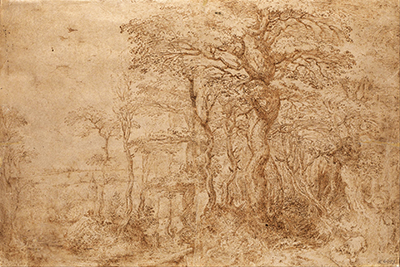Sylvan Landscape with Five Bears features a plethora of tall trees which fill the vertical space of most of this drawing. Bruegel would often place tall trees to either side of his compositions in order to frame the rest of the content, but here continues them throughout.
The term Sylvan refers to a peaceful, wooded area which were commonly used by Bruegel within his drawings. He biased further towards nature within this art form, where as in his paintings the human figures would be more obvious and prominent. Pen and wash would be used to produce a consistent look throughout his drawings, giving each element as much prominence as each other, except for perhaps where he uses slightly darker areas such as for shadows. It is this approach that helps the tallest tree within this artwork to take our main focus, with darker, closer lines added to its right hand side, as well as around the base of the trunk.
Bruegel was able to turn some of his drawings into prints by employing the services of specialist etchers and woodblock artists who could take these types of sketches and prepare them for the printing process. This enabled the artist to quickly generate an increased income as well as allowing him to spread his artistic reputation further afield. Many would do similar within Northern Europe and this also made art somewhat more attainable for the masses. Additionally, this had the other effect of helping landscape art to become more of a mainstream genre as at this time is was history and religious painting which dominated across most of Europe. The impact of that change is still being felt today, with landscape art now having completely surpassed religious work in terms of frequency and popularity.
This drawing can now be found in the Czech Republic National Gallery, in its capital, Prague. Visitors here can find a series of Klimt paintings as the main highlights, such as Water Castle (Kammer Chateau near Attersee I) and The Virgin. You will also discover the likes of Egon Schiele, Henri Rousseau and Edvard Munch within a varied collection that also includes much older styles as well. In all, it is an enjoyable selection of work that introduce us to the different styles of European art from the Renaissance up to the present day. The gallery remains one of the best venues in the country to discover some real cultural gems and focuses on European art as a whole, rather than only the narrower sphere of Czech artists alone. Their most famous artist remains Alphonse Mucha.




